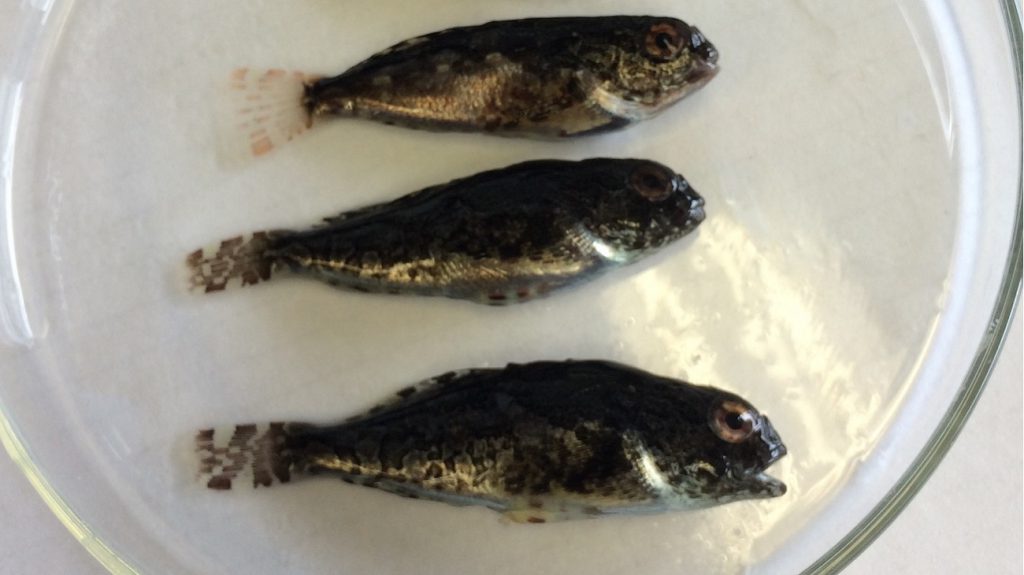Much of the information on SMURFs to date has focused on rockfish, but rockfish aren’t the only fish that we collect in the SMURFs. While rockfish may make the headlines with their huge pulses and interesting seasonal recruitment patterns, there is one reliable species which appears in the SMURFs nearly every week – the Cabezon. Cabezon, members of the sculpin family, are the third most frequently collected species in the SMURFs, and the most prevalent non-rockfish species. Here we’ll shine the spotlight on the Cabezon, a species which has often been overlooked in the past.

Perhaps the main reason Cabezon are overlooked is because natural selection has shaped them specifically for this purpose. Cabezon blend in well with their surroundings due to the mottled pattern of their skin. Adults are sit-and-wait predators who lie on the bottom waiting for prey to draw near enough for an ambush attack. Prey, for Cabezon, is a very broad term. All sorts of crustaceans, fishes, and mollusks may find themselves inside a Cabezon’s stomach. Cabezon, in turn, may find themselves inside the stomachs of larger fish, seabirds, marine mammals (e.g. sea lions and seals), and humans. Originally, Cabezon may have served as an important food source for Native Americans living in the Pacific Northwest. However, when Europeans made it to the West Coast, they originally shunned the species as a food source. The main reason for this? Frankly, they thought it was too ugly to eat. Cabezon, though possibly slightly offended, probably didn’t mind being called ugly if it kept them off of dinner plates. Fortunately for fishers, and unfortunately for the Cabezon, the appearance stigma gradually diminished with the advent of live fisheries.
So how and why do these homely bottom-dwellers end up in our SMURFs? Cabezon don’t spend their whole lives on the bottom. In fact, their early years are an exciting journey from place to place before settling to the bottom. As mentioned last week, Cabezon reproduce via external fertilization. Females release thousands of eggs at a time onto the rocks in shallow waters during spawning season, which peaks in Oregon during the late winter. Interestingly, male Cabezon guard the eggs after fertilizing them until they hatch. The eggs themselves are poisonous and ignored by predators (including humans). With paternal protection and poisonous eggs, it’s quite impressive the lengths Cabezon have gone to defend their eggs. Once hatched though, larvae are at the mercy of the ocean for 3-4 months before settling into shallower waters. This is where they cross paths with the SMURFers.
Nearly 2000 Cabezon have been collected in SMURFs over the past 7 years of monitoring. As discussed last week, their reproduction schedule means the peak of Cabezon collection occurs in early summer, with a gradual decrease in numbers throughout the summer. A week without collecting a Cabezon is a rare one. Of the 91 SMURF outings conducted since 2011, approximately 90% of the trips have collected at least one Cabezon. Impressively, Week 12 of this year marked the first time a Cabezon was not collected at Redfish Rocks while SMURFing. You may recall from the Week 12 post that two SMURFs and two moorings were lost before this outing, so perhaps the streak would have continued had all the SMURFs been in action.
A long spawning season, large spawning populations, and favorable oceanic conditions all may play a role in the Cabezon’s persistent presence in the SMURFs. All that can be said with certainty is that, while Cabezon may not have the flashy reputation of some of Oregon’s other fishes, SMURFers are quite fond of these unsightly sculpins.
This week, the Cabezon returned to Redfish Rocks and a new streak began! The three fish collected in the SMURFs were all Cabezon; it seems the midsummer lull is still in full swing. However, in addition to collecting, this week’s outing was also a maintenance mission. With the assistance of one of our commercial fisherman collaborators and his vessel, we were able to deploy replacement moorings. The full fleet of SMURFs at Redfish Rocks is officially back online and ready for action!
Excited to see how this new fleet fares? Keep checking back weekly for updates on SMURFing at both Redfish Rocks and Otter Rock Marine Reserves!
